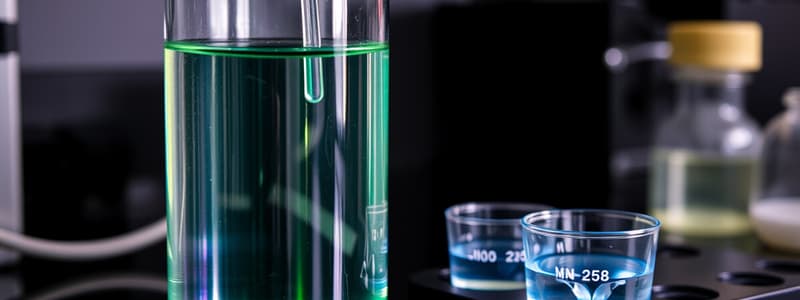Podcast
Questions and Answers
What is the main purpose of Atomic Absorption Spectrometry in water analysis?
What is the main purpose of Atomic Absorption Spectrometry in water analysis?
- Evaluate the presence of pathogens
- Assess the total dissolved solids in water
- Determine the pH of the sample
- Measure the concentration of a specific element (correct)
During the Winkler Titration, what is the purpose of adding manganese hydroxide?
During the Winkler Titration, what is the purpose of adding manganese hydroxide?
- To facilitate the reaction with iodine (correct)
- To increase the sample volume
- To prevent the evaporation of water
- To enhance the color of the solution
What indicator is used in the EDTA titration for measuring total hardness?
What indicator is used in the EDTA titration for measuring total hardness?
- Eriochrome Black T (correct)
- Phenolphthalein
- Methyl orange
- Bromothymol blue
What is the final color change when using Eriochrome Black T in EDTA titration?
What is the final color change when using Eriochrome Black T in EDTA titration?
What is the temperature at which Biochemical Oxygen Demand (BOD) is typically measured?
What is the temperature at which Biochemical Oxygen Demand (BOD) is typically measured?
What method is used to estimate suspended solids in a water sample?
What method is used to estimate suspended solids in a water sample?
Which solution is NOT part of the Winkler titration process?
Which solution is NOT part of the Winkler titration process?
What characteristic wavelength of light is absorbed by atoms in the ground state during Atomic Absorption Spectrometry?
What characteristic wavelength of light is absorbed by atoms in the ground state during Atomic Absorption Spectrometry?
How can dissolved solids in a sample be measured?
How can dissolved solids in a sample be measured?
Study Notes
Atomic Absorption Spectrometry
- Atoms in their ground state absorb light at specific wavelengths unique to each element.
- Used in water analysis to quantify the concentration of specific heavy metals.
Estimation of Suspended Solids
- Suspended solids in water can be estimated through filtration.
Biochemical Oxygen Demand (BOD)
- BOD measures the amount of dissolved oxygen (in ppm) consumed by biological processes at 20°C in darkness over 5 days.
Free Chlorine Effect in Swimming Pools
- Free chlorine oxidizes DPD, leading to the formation of a red-colored product.
Ammonium Molybdate in Phosphate Samples
- Adding ammonium molybdate results in the production of a yellow precipitate.
Dissolved Oxygen Measurement
- The Winkler Titration method is utilized for measuring dissolved oxygen (O₂) levels in water samples.
Total Hardness Measurement
- Total hardness can be quantified using EDTA titration.
pH Measurement
- pH can be assessed using litmus paper or universal indicator solutions.
Colorimetry Principle
- The principle of colorimetry states that the absorbance of color is directly proportional to the concentration of the solution.
Examples of Free Chlorine
- Common forms of free chlorine include Cl⁻, HOCl, and OCl⁻.
Measuring Dissolved Solids
- Dissolved solids can be measured by calculating the mass difference before and after evaporation in a basin.
EDTA Titration Specifics
- The indicator used is Eriochrome Black T.
- Color change during titration is from wine red to blue.
- The titration depends on pH, maintained at 9 using a pH buffer.
Winkler Titration Solutions
- Three solutions added are:
- Alkaline potassium iodide (KI)
- Concentrated sulfuric acid
- Manganese(II) hydroxide (Mn(OH)₂)
Small Concentrated Doses in Winkler Titration
- Small doses minimize the displacement of the water sample, preventing contamination.
Container Submersion
- The container must be fully submerged to avoid additional dissolved oxygen uptake from the atmosphere.
Iodine Solution Titration in Winkler Titration
- In the Winkler titration, iodine solution is titrated against sodium thiosulfate.
Studying That Suits You
Use AI to generate personalized quizzes and flashcards to suit your learning preferences.
Description
Test your understanding of Atomic Absorption Spectrometry and its application in water analysis. This quiz covers key principles such as Biochemical Oxygen Demand and estimating suspended solids in water samples. Challenge yourself with questions on analytical techniques used in environmental chemistry.




